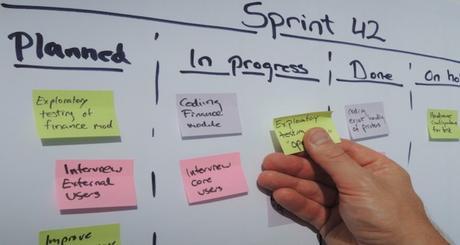
- March 5, 2015
- 0
- Email This Post
- Print This Post
Sprints, Scrums & Turning on a Dime: Is Agile Marketing for Small Business?
Know those integrated marketing plans you agonize over each year, planning every strategy and tactic to the nth detail? Such preparation could be a big waste of time–a relic of bygone days–says the Harvard Business Review (HBR), in a recent article touting the benefits of an evolving discipline called ‘Agile’ marketing.
Of course, software companies won’t consider Agile particularly novel. They practically invented the approach and still apply it with great success in their notoriously complex product- development cycles.
But for integrated marketers who are truly looking for new ways to outpace the competition and get products or services to market quickly, the principles of Agile could help accelerate results.
What is Agile Marketing?
As the name implies, ‘Agile’ is a methodology or approach that enables companies to react faster when unexpected events or obstacles threaten to hinder marketing plan execution.
Many marketers today do include ‘if-then’ contingencies (if X happens, we’ll do Y) and pre-planned responses to trends (rise in mobile device use) or hypothetical scenarios (what if ABC costs jump by 40 percent?).
But because many such developments with direct bearing on your plans can’t be accurately predicted, you may need an approach that’s far more flexible, that includes time-periods built-in to stop, tweak and, if needed, change course altogether. That’s Agile marketing in a nutshell.
Opportunities and Obstacles
A 2014 report from CMG Partners entitled “Agile for Marketing (A4M),” surveyed more than 40 CMOs, top marketers and other Agile experts, concluding that the biggest upsides of applying Agile methodologies to marketing are:
- Increased business performance–including faster creative development, more testing, higher team productivity and more focus on customer concerns and issues
- Greater adaptability–process and decisioning flexibility built into Agile systems equip businesses to quickly respond to positive or negative marketplace developments
- Happier, more fulfilled employees–CMOs reported a surprising jump in Agile teams’ pride and satisfaction, stemming from people having greater clarity about their responsibilities, and feeling more empowered
The biggest obstacles marketers face implementing Agile? The same ones encountered when trying to implement almost any new marketing initiative, including inherently cautious legacy processes that can hinder quick decisions.
“Many organizations are still challenged by complex organizational structures, a lack of collaboration, processes that slow them down, and a volume of work that causes teams to always be reacting [instead of] working on initiatives that will drive growth,” says CMG senior director, Barre Hardy. “It’s hard to create a culture of agility…if employees are afraid to fail or take risks,” he adds.
Walk Before You Run
Even if your small business can’t go all in with Agile, learning more about it, including which principles you could adopt, might have some benefit. This very good article from Forbes describes how to develop an Agile campaign, while this post from Survey Gizmo takes it a step further, offering a longer-form guide that explains intriguing Agile terms such as ‘Sprints,’ and ‘Scrums.’
But remember. Regardless of scale, Agile marketing will still be integrated.
So before tackling any Sprints or Scrums, we recommend treating yourself to a quick refresher on implementing social media, crafting press releases and getting your website ready to go prime time.
